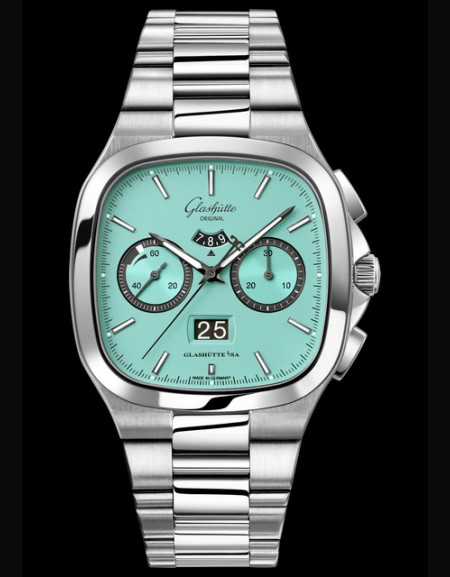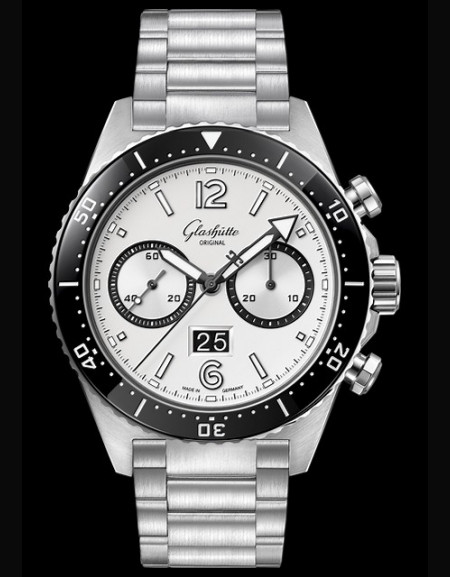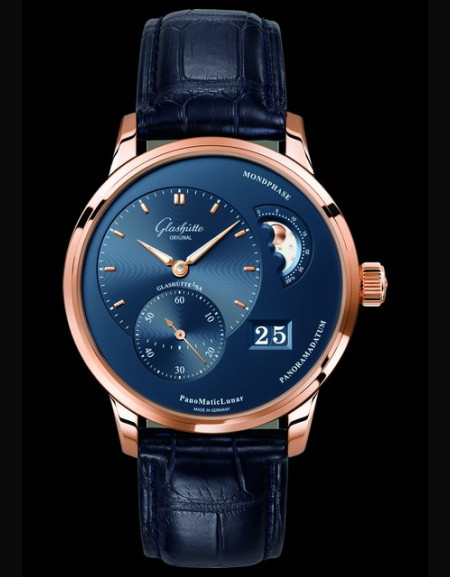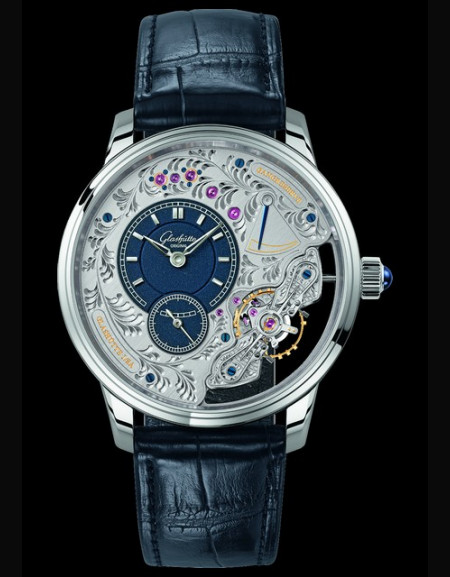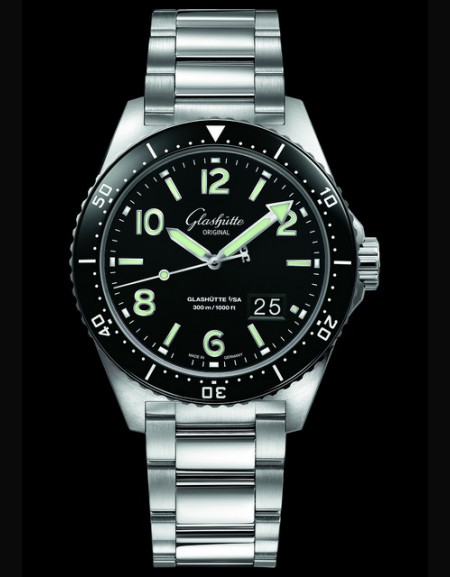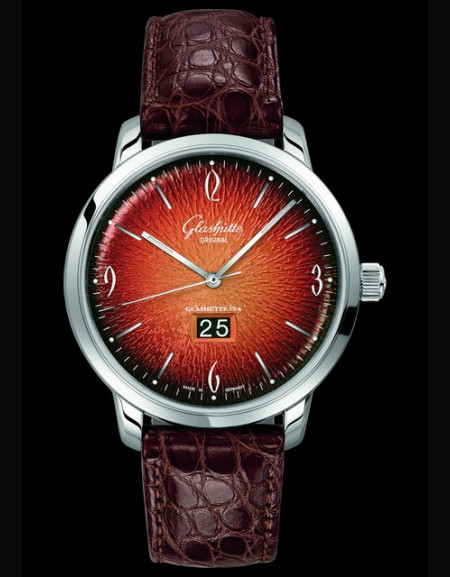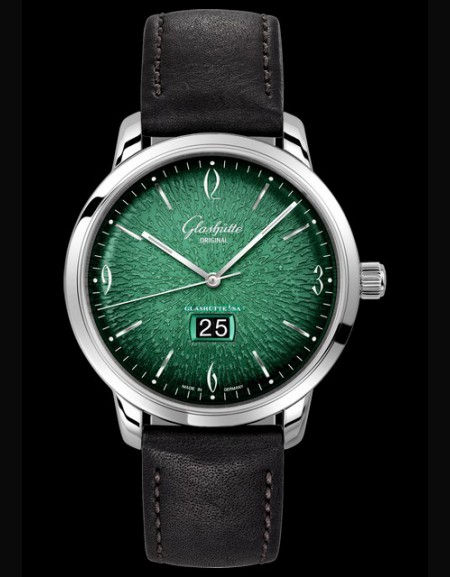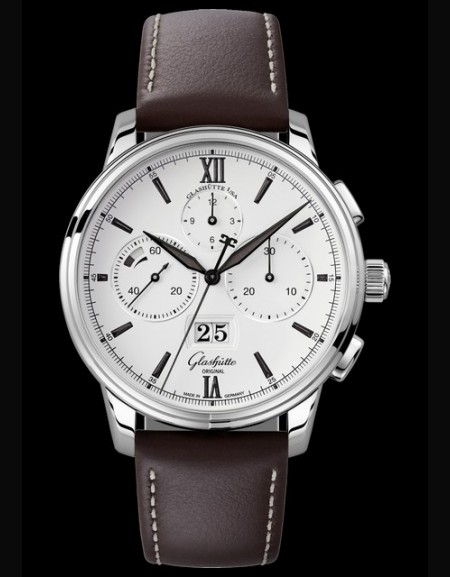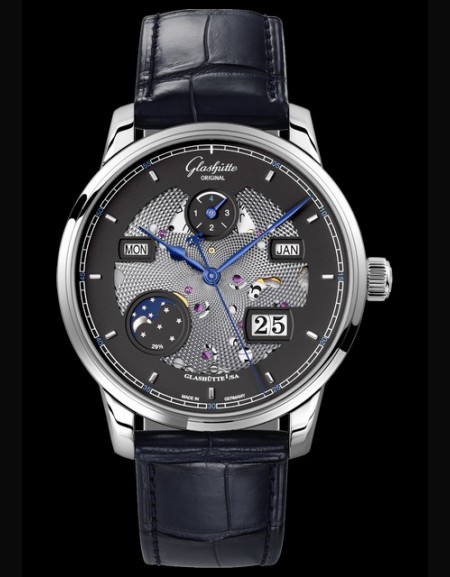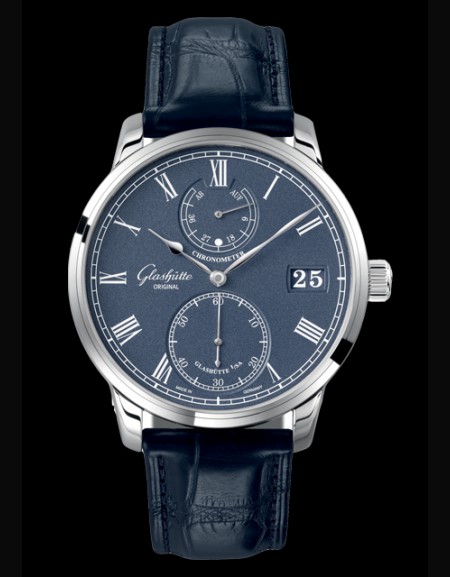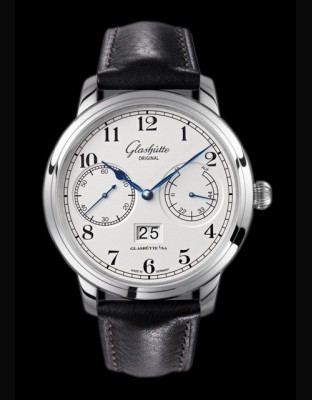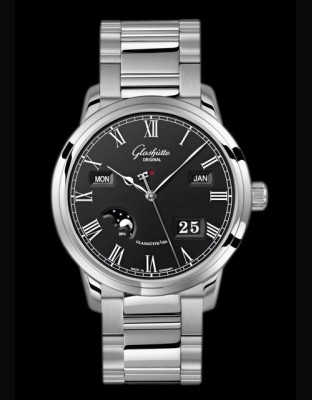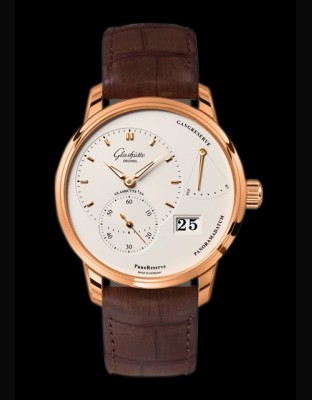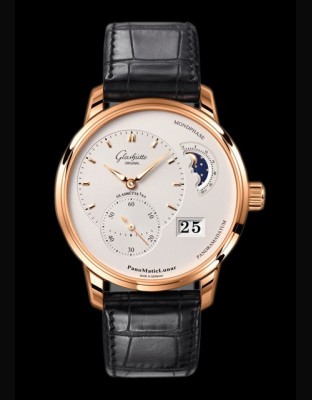
|
||
Glashütte Original history
The history of Glashütte Original has been characterized by eventful times. One thing has however always remained the same: the passion for true mechanical masterpieces made in the spirit of the traditional art of watchmaking coupled with the continuous search for new solutions. Take a journey through time...
1845 : After almost four centuries of mining, the silver found until then dried up at beginning of the nineteenth century and great poverty broke out over the town of Glashütte. Ferdinand Adolph Lange (1815-18...

THE COLLECTIONS

-
Seventies Chronograph...
SEE THE DATA SHEETCollection: Glashütte Original
Ref: 1-37-02-16-02-70
Price: 17 000 € -
Seventies Chronograph...
SEE THE DATA SHEETCollection: Glashütte Original
Ref: 1-37-02-17-02-70
Price: 17 000 € -
SeaQ Chronograph
SEE THE DATA SHEETCollection: Glashütte Original
Ref: 1-37-23-03-80-70
Price: 16 500 € -
Pano MaticLunar
SEE THE DATA SHEETBrand: Glashütte Original
Collection: Pano
Ref: 1-90-02-11-35-01
Price: 18 600 € -
Pano Reserve
SEE THE DATA SHEETBrand: Glashütte Original
Collection: Pano
Ref: 1-65-01-04-15-01
Price: 18 600 € -
PanoInverse Limited Edition
SEE THE DATA SHEETBrand: Glashütte Original
Collection: Pano
Ref: 1-66-08-01-03-30
Price: 45 400 € -
SeaQ Panorama Date
SEE THE DATA SHEETBrand: Glashütte Original
Collection: Spezialist
Ref: 1-36-13-01-80-70
Price: 12 300 € -
SeaQ 1969
SEE THE DATA SHEETBrand: Glashütte Original
Collection: Spezialist
Ref: 1-39-11-01-80-06
Price: 8 600 € -
Sixties Date Panorama
SEE THE DATA SHEETBrand: Glashütte Original
Collection: Sixties
Ref: 2-39-47-09-02-04
Price: 7 900 € -
SeaQ
SEE THE DATA SHEETBrand: Glashütte Original
Collection: Spezialist
Ref: 1-39-11-06-80-70
Price: 9 800 € -
Sixties
SEE THE DATA SHEETBrand: Glashütte Original
Collection: Sixties
Ref: 1-39-52-13-02-04
Price: 6 400 € -
Sixties Panorama Date
SEE THE DATA SHEETBrand: Glashütte Original
Collection: Sixties
Ref: 2-39-47-04-02-04
Price: 7 900 € -
Senator Chronograph...
SEE THE DATA SHEETBrand: Glashütte Original
Collection: Senator
Ref: 1-37-01-05-02-07
Price: 13 400 € -
Senator Chronograph...
SEE THE DATA SHEETBrand: Glashütte Original
Collection: Senator
Ref: 1-37-01-05-02-06
Price: 13 400 € -
Sixties
SEE THE DATA SHEETBrand: Glashütte Original
Collection: Sixties
Ref: 1-39-52-03-02-04
Price: 6 400 € -
Senator Excellence...
SEE THE DATA SHEETBrand: Glashütte Original
Collection: Senator
Ref: 1-36-02-03-04-01
Price: 33 200 € -
Senator Chronograph...
SEE THE DATA SHEETBrand: Glashütte Original
Collection: Senator
Ref: 1-37-01-05-02-70
Price: 14 900 € -
Senator Chronometer
SEE THE DATA SHEETBrand: Glashütte Original
Collection: Senator
Ref: 1-58-01-05-34-30
Price: 27 500 € -
Senator Observer 1911 -...
SEE THE DATA SHEETBrand: Glashütte Original
Collection: Senator
Ref: 100-15-04-04-04
Price: 26 700 € -
Senator Calendrier Perpétuel
SEE THE DATA SHEETBrand: Glashütte Original
Collection: Senator
Ref: 100-02-25-12-14
Price: 18 900 € -
Senator Calendrier Perpétuel
SEE THE DATA SHEETBrand: Glashütte Original
Collection: Senator
Ref: 100-02-22-12-14
Price: 18 900 € -
Senator Calendrier Perpétuel
SEE THE DATA SHEETBrand: Glashütte Original
Collection: Senator
Ref: 100-02-25-12-05
Price: 18 000 € -
Senator Calendrier Perpétuel
SEE THE DATA SHEETBrand: Glashütte Original
Collection: Senator
Ref: 100-02-25-12-04
Price: 18 000 € -
Senator Calendrier Perpétuel
SEE THE DATA SHEETBrand: Glashütte Original
Collection: Senator
Ref: 100-02-22-12-05
Price: 18 000 € -
Senator Calendrier Perpétuel
SEE THE DATA SHEETBrand: Glashütte Original
Collection: Senator
Ref: 100-02-22-12-04
Price: 18 000 € -
Senator Calendrier Perpétuel
SEE THE DATA SHEETBrand: Glashütte Original
Collection: Senator
Ref: 100-02-22-05-05
Price: 29 800 € -
Senator Calendrier Perpétuel
SEE THE DATA SHEETBrand: Glashütte Original
Collection: Senator
Ref: 100-02-22-05-04
Price: 29 800 € -
PanoReserve
SEE THE DATA SHEETBrand: Glashütte Original
Collection: Pano
Ref: 65-01-25-15-05
Price: 18 800 € -
PanoReserve
SEE THE DATA SHEETBrand: Glashütte Original
Collection: Pano
Ref: 65-01-25-15-04
Price: 18 800 € -
PanoReserve
SEE THE DATA SHEETBrand: Glashütte Original
Collection: Pano
Ref: 65-01-23-12-24
Price: 10 100 € -
PanoReserve
SEE THE DATA SHEETBrand: Glashütte Original
Collection: Pano
Ref: 65-01-23-12-04
Price: 9 200 € -
PanoMaticLunar
SEE THE DATA SHEETBrand: Glashütte Original
Collection: Pano
Ref: 90-02-45-35-05
Price: 18 600 €
Glashütte Original history
The history of Glashütte Original has been characterized by eventful times. One thing has however always remained the same: the passion for true mechanical masterpieces made in the spirit of the traditional art of watchmaking coupled with the continuous search for new solutions. Take a journey through time...
1845 : After almost four centuries of mining, the silver found until then dried up at beginning of the nineteenth century and great poverty broke out over the town of Glashütte. Ferdinand Adolph Lange (1815-1875), master watchmaker to the Saxon court, brought new hope to the place with the founding of the first watch manufactory. His vision was to make an independent Saxon watch industry concentrating on the production of high precision watches in comparably small numbers. Glashütte's municipal coat of arms, existing in its present form since 1912, displays the history of the city, a past first characterized by mining and then watchmaking.
1852 : Well-known watchmakers followed Lange's call, with Julius Assmann at the forefront. At his Deutsche Präzisions-Taschenuhrenfabrik, he manufactured precision watches outfitted with elements typical of Glashütte, such as the three-quarter plate and a hand-engraved balance cock, that were awarded prizes all over the world. A model from Julius Assmann's company is this pocket watch from around 1905 featuring a tripartite enameled dial typical of Glashütte and wonderfully decorative gold hands in Louis XV style.
1875 : After the first developments such as winding by crown, the Glashütte three-quarter plate, and the lever escapement, even more complex mechanisms were being made. The first Glashütte watch with a stop function (1863), repeaters, and calendar watches followed. The mechanical workshops of Strasser & Rohde were famed for their extraordinary precision pendulum clocks. They were founded in 1875 by the influential personalities Ludwig Strasser and Gustav Rohde.
1878 : The enormous international demand for Glashütte's precision watches called for more and more very specialized tradespeople. And thus Moritz Grossmann - also famous for his excellent pocket watches - founded the German School of Watchmaking (DUS), certainly one of the reasons for the economic success of the region's watch companies. Here the great instructors of the trade were able to pass on their knowledge. Illustrations of typical Glashütte movements served as teaching material, and the students also created these types of drawings themselves later.
1893 : At the end of 19th century only a few people could afford to buy the relatively expensive, but very good, watches made in Glashütte. Johannes Dürrstein, a businessman in the world of watches, decided to consistently do without everything that would make a watch more expensive on his UNION models. He underscored the technical know-how of his UNION watch factory, however, by making lavish timepieces again and again, such as the Universal Watch of 1901. Outfitted with eighteen complications it was the most complicated watch in the world for a long time.
1904 : Ernst Kasiske founded his own watch factory in 1898, which in 1904 was integrated into Glashütter Präzisionsuhrenfabrik Aktiengesellschaft and later became an individual company within the Uhrenrohwerkefabrik Glashütte (UROFA). In addition to the many important watchmakers, case makers and producers of hands and balances also settled in Glashütte. They supplied the individual companies who strove to make watches containing German-made components. Glashütte became the epitome of German precision horology and advanced to one of the era's most important centers of watchmaking, along with the Swiss Jura. Movements for observation watches with large compensation balances made of two metals were constructed around the turn of the century, guaranteeing an especially great amount of precision even despite changes in climate.
1913 : Former pupil Alfred Helwig was called to become an instructor at the German School of Watchmaking in Glashütte. With his extraordinary knowledge of fine adjustment and most especially with the invention of the flying tourbillon in 1920 he made a name for himself worldwide. His expert essay on "Karussel Watches" remains today one of the most important instructional works for tourbillon builders. A unique escapement model by Helwig made in 1927 at the German School of Watchmaking was bought at auction by Glashütte Original - and returned to the place of its birth.
1914-1918 : With the approach of World War I in 1914, the positive development that Glashütte had been enjoying came to an abrupt end, terminating the town's first heyday. Many watch companies had to let the majority of their employees go. No one knew how the sales of Glashütte precision watches would develop. After the end of the war, many companies were newly created. On November 9, 1918 Deutsche Präzisions-Uhrenfabrik Glashütte (DPUG) was entered into the registry of companies. The factory‘s origins were underscored with the words "Original Glashütte" in its logo.
1921 : The "Original Glashütte" logo appeared on a Deutsche Präzisionsuhrenfabrik Glashütte pocket watch dial for the first time in 1921. Thus, the company was able to set itself apart from the imitation pieces of "System Glashütte".
1926 : Following the severe world economic crisis of the early 1920s, many of Glashütte's companies were experiencing great financial difficulty. Additionally, the wristwatch was becoming ever more popular from 1919. When the Swiss watch embargo was lifted in 1924, Glashütte's relatively expensive wristwatches and pocket watches, which were no longer the fashion, had lost importance. With the express goal of not letting the Glashütte watch industry go under, two new companies, UROFA (Uhren-Rohwerke-Fabrik Glashütte AG) and UFAG (Uhrenfabrik Glashütte AG), were founded in 1926: important movement ébauches were supplied from then on by the Uhren-Rohwerke-Fabrik Glashütte (UROFA), which was created from the remains of Glashütter Präzisionsuhrenfabrik. The qualitatively very good and price-conscious wristwatches from Uhrenfabrik Glashütte (UFAG) were welcomed by many fans. The large G and the town name Glashütte made up the succinct logo of UFAG.
1939-1945 : The positive development of Glashütte's wristwatches ended in the 1930s with the beginning of World War II. The watch companies were obligated to manufacture "goods important to the war." The design of Glashütte's pilot's chronometers became a military secret in 1940. They were fantastic in their striking reliability and rate precision. On the very last day of World War II, May 8, 1945, Glashütte was subjected to an air raid. After the end of the war, numerous factories were expropriated and dismantled by Russian occupying forces. Once again, the unshakable will of Glashütte's watchmakers was called upon to restart.
1951-1989 : In the new political climate, it was the simple utilitarian wristwatch that shaped the development to follow. On July 1, 1951 all of Glashütte's independent watch companies were fused into one large conglomerate: VEB Glashütter Uhrenbetriebe. It included UROFA with its departments UFAG and Basalt, VEB Lange, VEB Feintechnik (formerly Gössel & Co. or Burkhard), VEB Messtechnik (formerly Mühle and Son), VEB Estler, VEB Präzision Glashütte (formerly Liwos), and the technical school Makarenko (founded in 1946). Shortage of foreign currencies and absent import opportunities demanded of Glashütte's residents the most autonomy possible in terms of education, research, and direct creation of value in their products. This was to begin with a movement design department, continue with tool making, and go right into the production of individual components. At times even jewel bearings, balances with balance springs, shock protection, and ball bearings for rotors were even manufactured there. A wide selection of observation pocket watches, chronographs, and above all wristwatches with timeless designs for everyday use was created. These watches were shock-resistant, water-resistant, and outfitted with a sweep seconds display and a date indication.The automatic era experienced its high point in the 1960s with the Spezimatic caliber. The marine chronometers from Glashütte were a big hit both domestically and internationally until 1978. Despite international trends toward quartz watches in the 1980s, the continuous maintenance of the knowledge and experience needed for the design, production, and assembly of mechanical watches, even in the socialist era, later had a very positive effect on the renaissance of Glashütte luxury watches.
1990 : The reunion of Germany caused VEB Glashütter Uhrenbetriebe to become Glashütter Uhrenbetrieb GmbH, a limited company. This firm is the legal successor to all of the previously founded companies belonging to Glashütte's watch community.
1994 : High-quality mechanical watches, manufactured in the tradition of the old masters: that is how the company returned to the exalted group of genuine watch manufactories. The brand name Glashütte Original is a synonym for watch movements that are conceived, designed, and manufactured in exceptional depth of production at the company itself.
1995 : In the spring, the manufactory celebrated its first new appearance on the market with a collection of three-handed automatics, an automatic chronograph, and a manually wound chronometer. An absolute highlight on the occasion of the 150th anniversary of Glashütte watch production was the most complicated and expensive watch in Glashütte's modernera: the Julius Assmann 1 - a masterpiece outfitted with a perpetual calendar and a flying tourbillon. This masterpiece can be worn as both a pocket and a wristwatch.
1996 : 1845 - the founding year of the first watch manufactory in Glashütte - gives this popular collection outfitted wtih manually wound Calibers 42 and 49 its name. The 1845 Special Edition model Alfred Helwig Flying Tourbillon, limited to only 25 pieces and outfitted with very fine Caliber 41, was sold out within just a short period of time. With its new Sport collection the manufactory won over ever more fans of striking, robust watches.
1997 : For the production of the special edition model Julius Assmann 2, the Glashütte Original watch manufactory decided to cooperate for the first time with the porcelain manufactory Meissen. The fine mechanics of Caliber 52 are crowned with a dial made of paper-thin, hand-painted Meissen porcelain. Worldwide there were only 25 pieces - each one definitely a unique piece. Today already a classic: the Senator Edition was impressive with its new Caliber 39, the first automatic movement with swan-neck fine adjustment and a skeletonized rotor. And the ladies weren't forgotten either: the Lady Sport Edition pleased sports-oriented females and ambitioned businesswomen alike.
1998 : Edgy - the new Karree models of the 1845, Senator, and Lady collections demonstrated a multifaceted uniting of avant-garde and classic. For the special edition model Karree Tourbillon, a special manually wound shaped movement, Caliber 43, with a fully new movement design was created. The cooperation with the porcelain manufactory Meissen was successfully continued in the 1845 Meissen and Lady Meissen editions.
1999 : Haute horlogerie of the finest sort: The new Senator Perpetual Calendar united demanding complications with the functionality of the modern. In the same year, the readers of the Austrian magazine Die Presse crowned this model the winner in the competition's most interesting category: "Complicated Watch."
2000 : The Senator Perpetual Calender was honored with the sought-after title Watch of the Year by the readers of the German watch magazine ArmbandUhren and the German national newspaper Welt am Sonntag. With the introduction of the PanoRetroGraph, there was simultaneously a world premiere: the first mechanical chronograph that can also count backwards. Its off- center dial design was also the platform for the new PanoDate Edition. Now it was the goal to make this innovative manufactory art directly tangible for even more watch lovers. Through a strategic alliance with the Swatch Group AG, the manufactory was able to find quick entry to competent watch dealers all over the world.
2001 : Connoisseurs of mechanical watches honored the innovation and horological demand of the PanoRetroGraph with the title of Watch of the Year. Glashütte tradition was also always present: the Alfred Helwig Tourbillon 2 represented another exclusive homage to the life's work of one of the best master watchmakers. His portrait was displayed on a solid gold dial plate on the rose gold model and on a hand-painted plate made of Meissen porcelain on the platinum model. Additionally, at its first Glashütte Watch Boutique in Frankfurt the manufactory presented not only the current collection, but also historical special editions, escapement models, and marine chronometers.
2002 : The new Alfred Helwig School of Watchmaking offers up to fifteen young people a modern education in watchmaking and tool making each year. Alongside the PanoReserve with its new duplex swan-neck spring and the PanoGraph, the Julius Assmann 3 model attracted a great number of looks in the same year: very finely skeletonized and outfitted with a flying tourbillon, a retrograde date hand, and a power reserve display.
2003 : Three models within the PanoDate Edition defined a new automatic line. Caliber 90 of the PanoMaticDate and PanoMaticLunar show an individual face with their eccentric winding rotors and duplex swan-neck springs. The limited PanoMaticTourbillon joined the flying tourbillon with the comfort of automatic winding. Innovative concepts were also in evidence at the new factory in Glashütte: a transparent style of architecture and tours on the learning path invited the interested party to take a direct look at Glashütte Original's lavish style of production. Additional concerts, readings, and exhibitions created an open meeting place.
2004 : New types of solutions inside and out: the PanoMaticChrono convinced watch lovers of this with various dial levels and a patented bilaterally winding stepped gear that made a targeted transmission of winding energy to the serial spring barrels possible. In the same year, the PanoMaticChrono won first prize at International Watch's readers' vote in the category "Chronograph. The Saeculum Glashütte Original Music Festival Prize proved the manufactory's cultural commitment. True to the motto "quality is not a question of time," from this point on the special life's work of an artist has been honored. In 2004 it was the famous conductor and music director Prof. Kurt Masur. Another new beginning was represented by the first class to go through the Alfred Helwig School of Watchmaking, which successfully completed its education in this year. All graduates were offered a job at Glashütte Original.
2005 : After 2000 and 2001, a Glashütte Original was once again awarded the title Watch of the Year at Baselworld. With a decisive lead over the competition, the PanoMaticChrono was very obviously high on connoisseurs' lists. The new design of the Senator interpreted a classic men's watch with a modern twist. Its excellently finished Caliber 100 was for the first time outfitted with a reset mechanism. Sport Evolution also showed itself in a new, expressive look with an innovative buckle. The Star Collection defined the glamorous, precious line and was outfitted with manufacture movements 65 and 90 on the inside. Very publicly, Glashütte Original presented horological perfection with a truly unique piece: the Frauenkirchenuhr. This masterpiece's dial was made of Meissen porcelain and bore as its motif Dresden's Church of our Lady (Frauenkirche). The proceeds from its auction were donated to the rebuilding of the famous church. For the second time, Glashütte Original honored special achievements in the musical arts: The Saceulum Music Festival Award 2005 went to famed American ballet
choreographer John Neumeier.
2006 : The PanoMaticTourbillon was victorious in the top category at the 'Golden Balance 2006' competition in February. The historical establishment of the 'German Watch Museum Glashütte' took place in the manufactory's atrium by signing the official paperwork on March 16, 2006. With the Tourbillon Regulator and the Senator Calendar Week the manufactory presented two exceptional masterpieces of Haute Horlogerie. Looking back on a long tradition in the design and manufacture of pilot's watches, the engineers also created two new pilot's in the watch models Senator Navigator Automatic and Senator Navigator Panorama Date. Two exclusive editions were introduced as an homage to the long tradition of Glashütte (500 years) and Saxony's capital Dresden (800 years). The manufactory's customer magazine Momentum was honored with Best of Corporate Publishing Award (BCP) in June. At the end of the year, Glashütte Original won four first places at International Watch Awards in China and Austria with the Senator Calendar Week, GoldenDragon, SeaShell and Senator Navigator Panorama Date.
2007 : The start into the New Year was successfully once again: At 2007's Golden Balance, the PanoMaticVenue took first place in Category "Watches to 10,000 Euros". On the occasion of the 155th anniversary of the founding of J. Assmann Glashütte/i. Sa., the manufactory created the Julius Assmann 4 - a skeletonized masterpiece with a tourbillon and a retrograde hour display. For many experts, the absolute highlight at the Baselworld marked the Senator Rattrapante containing a split-second chronograph in the manual winding caliber 99. In remembrance to joie de vivre of the "wild '60s", Glashütte Original introduced the new Senator Sixties edition with domed sapphire crystals on top and bottom. The creative spirit was also reflected by the Senator Meissen with individually numbered porcelain dial, as well with the new Pano XL and Lady Serenade edition - each leaded by an exclusive tourbillon model. A traditional topping-out ceremony took place at the construction site of the German Watch Museum Glashütte on June 28, 2007, celebrating the end of an important construction phase. During the year, Glashütte Original also expanded its international presence, e.g. with the inauguration of the first Boutique Japan at the new Nicolas G. Hayek Center in Tokyo, the brand launch in Australia and the opening of a flagship stores at "The Venetian Macao". The exceptional corporate identity of the German luxury watch manufactory made its mark on national and international competitions. Glashütte Original received five awards: three for the customer magazine MOMENTUM, one for the entire positioning of the brand Glashütte Original and the image film "Handmade in Germany."
2008 : The duplex swan-neck fine adjustment introduced by Glashütte Original in 2002 got the attention it deserves on the dial of a watch. This impressive changeover was shown at the PanoInverse XL. Within the Sport Evolution, the manufactory surprised with a 'perpetual globetrotter': a perpetual calendar with an additional bezel for a second timezone. The optimum protection of the movement had been the focus of the development efforts for the Sport Evolution Impact Tourbillon and Chronograph. Four cushioning elements made of elastomer absorb up to 60% of the impact forces. Three further chronograph models were added to the Sixties, the Senator Navigator ("Chrono Award 2008" in Austria) as well as the Lady Serenade. A watch with a very special history was the 1878 Limited Edition. For Glashütte, May 1, 1878, was an important date. On this particular day, the German School of Watchmaking in Glashütte was founded on the initiative of watch manufacturer Moritz Großmann. On 22nd May 2008, the official opening of the German Watch Museum Glashütte took place in the historical building of the school. Consistent with the goals of the foundation "German Watch Museum Glashütte - Nicolas G. Hayek", Glashütte Original developed an exhibition journey which conveys the rich history of Glashütte as well as aspects relating to the sensation of time and its measurement. Just after five months, the museum welcomed its 25,000th visitor at the end of October.
2009 : For the special moments in life… The new Senator Chronometer was made for these. Glashütte Original's first chronometer with official certificate offered a new stop seconds / reset mechanism combined with an innovative minute detent allows the precise time to be easily set on the manual winding Caliber 58-01. It has been not just one of the "talking pieces" at the Baselworld 2009, but also the highlight of exclusive launch shows in Berlin, Zürich, Hong Kong, New York and Moscow as well as of the Glashütte Original TV spot shown on n-tv. As master of its class, the Senator Meissen Tourbillon united the Meissen porcelain and Alfred Helwig's flying tourbillon for the first time. The demanding approach was honored with the title "Watch of the Year 2009" (Complex Mechanism) in Austria. The new Senator Sixties Square Chronograph also convinced the watch enthusiasts, especially the readers of the Diners Club Magazine ('Mechanical Watch of the Year 2009"). Two new perpetual calendar were presented as Navigator version or housed in new ceramic case, while the new Sport Evolution Impact Panorama Date offered a PVD coated case.
As very special previews for 2010, the manufactory showed the limited Strasser & Rohde Regulator and the Glashütte Original Pocket Watch No. 1. Unique masterpieces have been also exhibited by the German Watch Museum Glashütte at the HK Art 09 in Hong Kong and in Wuhan (China). In Glashütte, the museum welcomed its 50,000 visitor in July - just 14 months after the opening.Two exceptional classical highlights were presented by the manufactory in Dresden: one at the Semper Opera with the Concertgebouw Orchester Amsterdam & Gustavo Dudamel(Glashütte Original SAECULUM Music Festival Prize 2009) and one at the Church of our Lady with the Vienna Philharmonic & Valery Gergiev.
